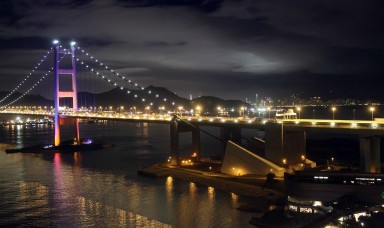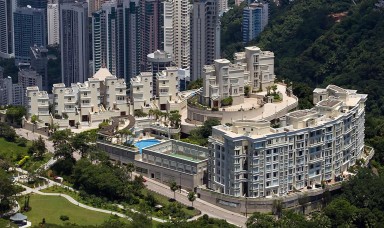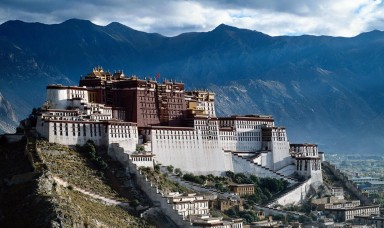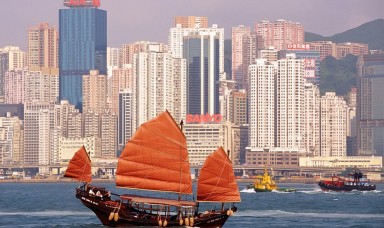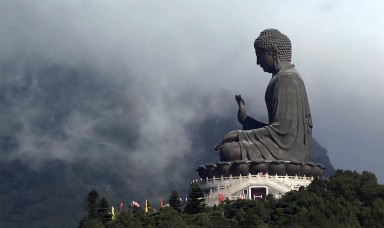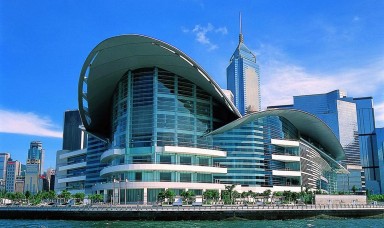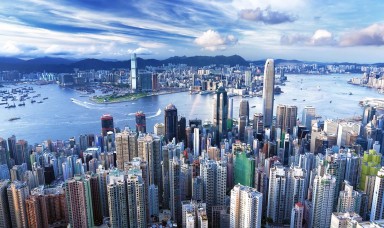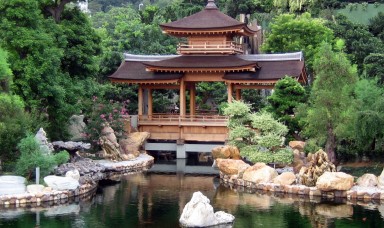 Hong Kong
Hong Kong
Hong Kong (香港, see Name section) is one of the two Special Administrative Regions of the People’s Republic of China, the other being Macau. It is situated on China’s south coast and, enclosed by the Pearl River Delta and South China Sea, it is known for its expansive skyline and deep natural harbour. With a land mass of 1,104 km2 (426 sq mi) and a population of seven million people, Hong Kong is one of the most densely populated areas in the world. Hong Kong’s population is 93.6% ethnic Chinese and 6.4% from other groups. Hong Kong’s Cantonese-speaking majority originate mainly from the neighbouring Canton (now Guangdong) province, from which many of them fled to escape wars and Communist rule in the 1930s to the 1960s.
- GEOGRAPHICAL DATA
- DEMOGRAPHICS
- ADMINISTRATIVE DIVISIONS
- ECONOMY
- CULTURE
Hong Kong is located on China’s south coast, 60 km (37 mi) east of Macau on the opposite side of the Pearl River Delta. It is surrounded by the South China Sea on the east, south, and west, and borders the Guangdong city of Shenzhen to the north over the Shenzhen River. The territory’s 1,104 km2 (426 sq mi) area consists of Hong Kong Island, the Kowloon Peninsula, the New Territories, and over 200 offshore islands, of which the largest is Lantau Island. Of the total area, 1,054 km2 (407 sq mi) is land and 50 km2 (19 sq mi) is inland water. Hong Kong claims territorial waters to a distance of 3 nautical miles (5.6 km). Its land area makes Hong Kong the 179th largest inhabited territory in the world.
As much of Hong Kong’s terrain is hilly to mountainous with steep slopes, less than 25% of the territory’s landmass is developed, and about 40% of the remaining land area is reserved as country parks and nature reserves. Most of the territory’s urban development exists on Kowloon peninsula, along the northern edge of Hong Kong Island, and in scattered settlements throughout the New Territories. The highest elevation in the territory is at Tai Mo Shan, 957 metres (3,140 ft) above sea level. Hong Kong’s long and irregular coast provides it with many bays, rivers and beaches. On 18 September 2011, UNESCO listed the Hong Kong National Geopark as part of its Global Geoparks Network. Hong Kong Geopark is made up of eight Geo-Areas distributed across the Sai Kung Volcanic Rock Region and Northeast New Territories Sedimentary Rock Region.
Despite Hong Kong’s reputation of being intensely urbanised, the territory has tried to promote a green environment, and recent growing public concern has prompted the severe restriction of further land reclamation from Victoria Harbour. Awareness of the environment is growing as Hong Kong suffers from increasing pollution compounded by its geography and tall buildings. Approximately 80% of the city’s smog originates from other parts of the Pearl River Delta.
Though it is situated just south of the Tropic of Cancer, Hong Kong has a humid subtropical climate (Köppen Cwa). Summer is hot and humid with occasional showers and thunderstorms, and warm air coming from the southwest. Summer is when typhoons are most likely, sometimes resulting in flooding or landslides. Winters are mild and usually start sunny, becoming cloudier towards February; the occasional cold front brings strong, cooling winds from the north. The most temperate seasons are spring, which can be changeable, and autumn, which is generally sunny and dry. Hong Kong averages 1,948 hours of sunshine per year, while the highest and lowest ever recorded temperatures at the Hong Kong Observatory are 36.1 °C (97.0 °F) and 0.0 °C (32.0 °F), respectively.
The territory’s population in 2011 is 7.07 million, with an average annual growth rate of 0.6% over the previous five years. Residents from mainland China do not have the right of abode in Hong Kong, nor are they allowed to enter the territory freely. However, the influx of immigrants from mainland China, approximating 45,000 per year, is a significant contributor to its population growth – a daily quota of 150 Mainland Chinese with family ties in Hong Kong are granted a “one way permit”. Life expectancy in Hong Kong is 79.16 years for males and 84.79 years for females as of 2009, making it one of the highest life expectancies in the world.
About 93.6% of the people of Hong Kong are of Chinese descent, the majority of whom are Taishanese, Chiu Chow, other Cantonese people, and Hakka. Hong Kong’s Han majority originate mainly from the Guangzhou and Taishan regions in Guangdong province. The remaining 6.4% of the population is composed of non-ethnic Chinese. There is a South Asian population of Indians, Pakistanis and Nepalese; some Vietnamese refugees have become permanent residents of Hong Kong. There are also Britons, Americans, Canadians, Japanese, and Koreans working in the city’s commercial and financial sector.4] In 2008, there were an estimate of 252,500 foreign domestic helpers from Indonesia and the Philippines working in Hong Kong.
Hong Kong’s de facto official language is Cantonese, a Chinese language originating from Guangdong province to the north of Hong Kong. English is also an official language, and according to a 1996 by-census is spoken by 3.1 percent of the population as an everyday language and by 34.9 percent of the population as a second language. Signs displaying both Chinese and English are common throughout the territory. Since the 1997 handover, an increase in immigrants from mainland China and greater integration with the mainland economy have brought an increasing number of Mandarin speakers to Hong Kong.
A majority of residents of Hong Kong would claim no religious affiliation, professing a form of agnosticism or atheism. According to the U.S Department of State only 43 percent of the population practices some form of religion. Some figures put it higher, according to a Gallup poll, 64% of Hong Kong residents do not believe in any religion, and possibly 80% of Hong Kong claim no religion. In Hong Kong teaching evolution won out in curriculum dispute about whether to teach other explanations, and that creationism and intelligent design will form no part of the senior secondary biology curriculum.
Hong Kong enjoys a high degree of religious freedom, guaranteed by the Basic Law. Hong Kong’s main religions are Buddhism, Taoism and Confucianism; a local religious scholar in contact with major denominations estimates there are approximately 1.5 million Buddhists and Taoists. A Christian community of around 833,000 forms about 11.7% of the total population; Protestants forms a larger number than Roman Catholics at a rate of 4:3, although smaller Christian communities exist, including the Latter-Day Saints and Jehovah’s Witnesses. The Anglican and Roman Catholic churches each freely appoint their own bishops, unlike in mainland China. There are also Sikh, Muslim, Jewish, Hindu and Bahá’í communities. The practice of Falun Gong is tolerated.
Statistically Hong Kong’s income gap is the greatest in Asia Pacific. According to a report by the United Nations Human Settlements Programme in 2008, Hong Kong’s Gini coefficient, at 0.53, was the highest in Asia and “relatively high by international standards”. However, the government has stressed that income disparity does not equate to worsening of the poverty situation, and that the Gini coefficient is not strictly comparable between regions. The government has named economic restructuring, changes in household sizes, and the increase of high-income jobs as factors that have skewed the Gini coefficient.
Hong Kong has a unitary system of government; no local government has existed since the two municipal councils were abolished in 2000. As such there is no formal definition for its cities and towns. Administratively, Hong Kong is subdivided into 18 geographic districts, each represented by a district council which advises the government on local matters such as public facilities, community programmes, cultural activities, and environmental improvements.
There are a total of 534 district council seats, 405 of which are elected; the rest are appointed by the Chief Executive and 27 ex officio chairmen of rural committees. The Home Affairs Department communicates government policies and plans to the public through the district offices.
As one of the world’s leading international financial centres, Hong Kong has a major capitalist service economy characterised by low taxation and free trade. The currency, Hong Kong dollar, is the eighth most traded currency in the world as of 2010. Hong Kong was once described by Milton Friedman as the world’s greatest experiment in laissez-faire capitalism, but has since instituted a regime of regulations including a minimum wage. It maintains a highly developed capitalist economy, ranked the freest in the world by the Index of Economic Freedom every year since 1995. It is an important centre for international finance and trade, with one of the greatest concentrations of corporate headquarters in the Asia-Pacific region, and is known as one of the Four Asian Tigers for its high growth rates and rapid development from the 1960s to the 1990s. Between 1961 and 1997 Hong Kong’s gross domestic product grew 180 times while per-capita GDP increased 87 times over.
The Hong Kong Stock Exchange is the seventh largest in the world, with a market capitalisation of US$2.3 trillion as of December 2009. In that year, Hong Kong raised 22 percent of worldwide initial public offering (IPO) capital, making it the largest centre of IPOs in the world and the easiest place to raise capital. The Hong Kong dollar has been pegged to the U.S. dollar since 1983.
The Hong Kong Government has traditionally played a mostly passive role in the economy, with little by way of industrial policy and almost no import or export controls. Market forces and the private sector were allowed to determine practical development. Under the official policy of “positive non-interventionism”, Hong Kong is often cited as an example of laissez-faire capitalism. Following the Second World War, Hong Kong industrialised rapidly as a manufacturing centre driven by exports, and then underwent a rapid transition to a service-based economy in the 1980s. Since then, it has grown to become a leading center for management, financial, IT, business consultation and professional services.
Hong Kong matured to become a financial centre in the 1990s, but was greatly affected by the Asian financial crisis in 1998, and again in 2003 by the SARS outbreak. A revival of external and domestic demand has led to a strong recovery, as cost decreases strengthened the competitiveness of Hong Kong exports and a long deflationary period ended. Government intervention, initiated by the later colonial governments and continued since 1997, has steadily increased, with the introduction of export credit guarantees, a compulsory pension scheme, a minimum wage, anti-discrimination laws, and a state mortgage backer.
The territory has little arable land and few natural resources, so it imports most of its food and raw materials. Imports account for more than 90% of Hong Kong’s food supply, including nearly all of the meat and rice available there. Agricultural activity—relatively unimportant to Hong Kong’s economy and contributing just 0.1% of its GDP—primarily consists of growing premium food and flower varieties. Hong Kong is the world’s eleventh largest trading entity, with the total value of imports and exports exceeding its gross domestic product. It is the world’s largest re-export centre. Much of Hong Kong’s exports consist of re-exports, which are products made outside of the territory, especially in mainland China, and distributed via Hong Kong. Its physical location has allowed the city to establish a transportation and logistics infrastructure that includes the world’s second busiest container port and the world’s busiest airport for international cargo. Even before the transfer of sovereignty, Hong Kong had established extensive trade and investment ties with the mainland, which now enable it to serve as a point of entry for investment flowing into the mainland. At the end of 2007, there were 3.46 million people employed full-time, with the unemployment rate averaging 4.1% for the fourth straight year of decline. Hong Kong’s economy is dominated by the service sector, which accounts for over 90% of its GDP, while industry constitutes 9%. Inflation was at 2.5% in 2007. Hong Kong’s largest export markets are mainland China, the United States, and Japan.
As of 2010 Hong Kong is the eighth most expensive city for expatriates, falling from fifth position in the previous year. Hong Kong is ranked fourth in terms of the highest percentage of millionaire households, behind Switzerland, Qatar, and Singapore with 8.5 percent of all households owning at least one million US dollars. In 2011, Hong Kong was ranked second in the Ease of Doing Business Index, behind Singapore.
Hong Kong is frequently described as a place where “East meets West”, reflecting the culture’s mix of the territory’s Chinese roots with influences from its time as a British colony. Concepts like feng shui are taken very seriously, with expensive construction projects often hiring expert consultants, and are often believed to make or break a business. Other objects like Ba gua mirrors are still regularly used to deflect evil spirits, and buildings often lack any floor number that has a 4 in it, due to its similarity to the word for “die” in Cantonese. The fusion of east and west also characterises Hong Kong’s cuisine, where dim sum, hot pot, and fast food restaurants coexist with haute cuisine.
Hong Kong is a recognised global centre of trade, and calls itself an “entertainment hub”. Its martial arts film genre gained a high level of popularity in the late 1960s and 1970s. Several Hollywood performers, notable actors and martial artists have originated from Hong Kong cinema, notably Bruce Lee, Jackie Chan, Chow Yun-fat, Michelle Yeoh, Maggie Cheung and Jet Li. A number of Hong Kong film-makers have achieved widespread fame in Hollywood, such as John Woo, Wong Kar-wai, and Stephen Chow. Homegrown films such as Chungking Express, Infernal Affairs, Shaolin Soccer, Rumble in the Bronx, In the Mood for Love and Echoes of the Rainbow have gained international recognition. Hong Kong is the centre for Cantopop music, which draws its influence from other forms of Chinese music and Western genres, and has a multinational fanbase.
The Hong Kong government supports cultural institutions such as the Hong Kong Heritage Museum, the Hong Kong Museum of Art, the Hong Kong Academy for Performing Arts, and the Hong Kong Philharmonic Orchestra. The government’s Leisure and Cultural Services Department subsidises and sponsors international performers brought to Hong Kong. Many international cultural activities are organised by the government, consulates, and privately.
Hong Kong has two licensed terrestrial broadcasters – ATV and TVB. There are three local and a number of foreign suppliers of cable and satellite services. The production of Hong Kong’s soap dramas, comedy series, and variety shows reach audiences throughout the Chinese-speaking world. Magazine and newspaper publishers in Hong Kong distribute and print in both Chinese and English, with a focus on sensationalism and celebrity gossip. The media in Hong Kong is relatively free from official interference compared to Mainland China, although the Far Eastern Economic Review points to signs of self-censorship by media whose owners have close ties to or business interests in the People’s Republic of China and states that even Western media outlets are not immune to growing Chinese economic power.
Hong Kong offers wide recreational and competitive sport opportunities despite its limited land area. It sends delegates to international competitions such as the Olympic Games and Asian Games, and played host to the equestrian events during the 2008 Summer Olympics. There are major multipurpose venues like Hong Kong Coliseum and MacPherson Stadium. Hong Kong’s steep terrain and extensive trail network with expansive views attracts hikers, and its rugged coastline provides many beaches for swimming.

